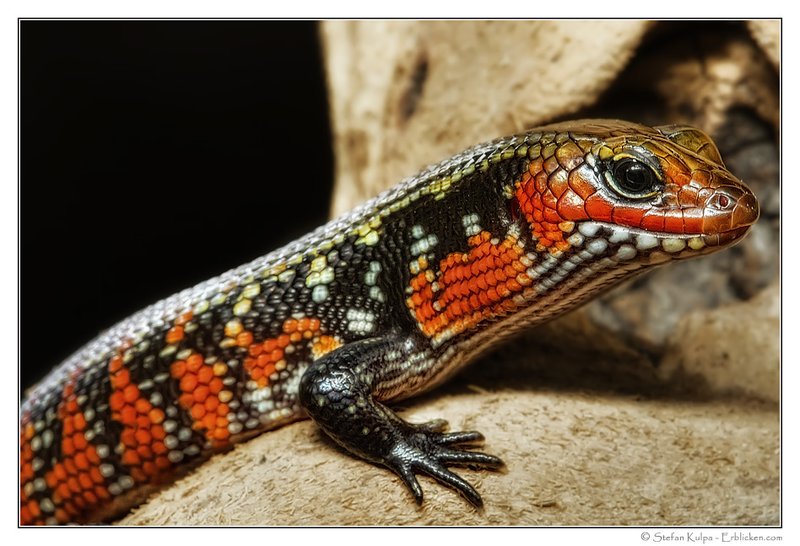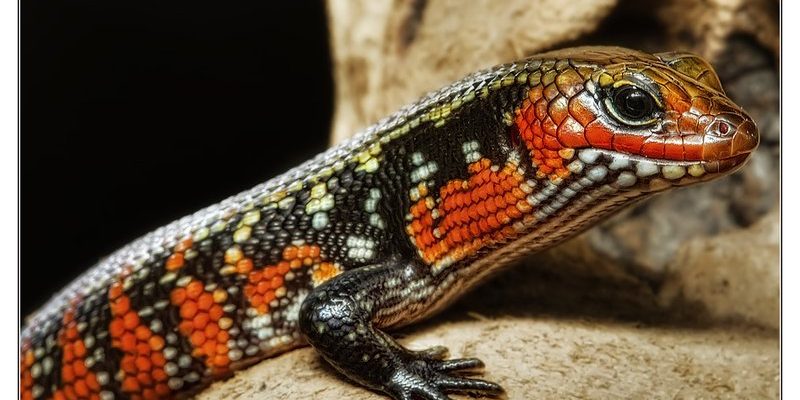
Imagine having a tiny dragon in your living room. That’s the vibe you get with fire skinks. They possess a fiery orange to red coloration on their sides, contrasted with dark, almost mystical stripes along their bodies. Honestly, they look like they belong in a fantasy novel! But there’s so much more beneath that stunning exterior. Whether you’re a curious newcomer or a seasoned reptile lover, learning about these reptiles can spark your fascination and perhaps even inspire you to add one to your collection.
Now, let’s take a closer look at the ten most intriguing facts that will give you a new appreciation for the vivacious fire skink.
1. Origin and Habitat
Fire skinks, or *Mochlus lignicolus*, originate from Africa, primarily found in regions like West Africa and parts of the Congo Basin. These guys thrive in humid forest environments, often hiding beneath leaf litter or in burrows. If you’ve ever watched a nature show where animals seem to just blend into their surroundings, that’s exactly how fire skinks operate. Their natural camouflage helps them stay safe from predators.
In captivity, they need a habitat that mimics their natural environment. Providing a warm, humid environment with plenty of hiding spots—like logs or plants—is essential. Here’s the thing: if you give them the right setup, they’ll be much happier and healthier. Think of it as creating a cozy little hideaway that they can call home.
2. Their Unique Coloration
You might think, “What’s the big deal about their colors?” But trust me, there’s a lot more to it. The fire skink’s vibrant hue isn’t just for show; it serves several important purposes. Bright colors can signal health and vitality, attracting mates during breeding season. They often take on a bright orange or red color that stands out against the lush green of their habitat.
This coloration can also help them regulate their temperature. You know how wearing darker clothing in the sun can make you feel hotter? The same concept applies here. Their darker stripes can absorb sunlight, helping them maintain an optimal body temperature. So, those beautiful colors are not only eye-catching but also functional!
3. Social Creatures with Interesting Behaviors
You might picture skinks as solitary creatures, but fire skinks can actually be quite social, especially when it comes to their interaction with others of their kind. They often live in small groups and enjoy basking together. It’s like having a little reptile community! These interactions are vital for their well-being, as they offer social stimulation and opportunities for play.
When they feel threatened, fire skinks display some unique defensive behaviors. Instead of running away, they might puff up their bodies, showing off their bright colors as a warning to potential threats. Plus, their amazing ability to drop their tails when caught can help them escape from predators. It’s quite the dramatic exit!
4. Diet and Feeding Habits
Fire skinks have a diverse diet that primarily consists of insects and other invertebrates. You might think of them as picky eaters, but they actually enjoy a wide variety of foods! Crickets, mealworms, and waxworms are some of their favorites. Providing a balanced diet is crucial for their health, as it supports their stunning coloration and energy levels.
In captivity, some owners even try to replicate their natural hunting behaviors by offering live food. If you’ve ever watched a cat stalk its prey, you know how thrilling it can be. Fire skinks are no different; they’ll dart around, eagerly catching their dinner. It’s a little show right in your living room!
5. Breeding and Reproduction
Breeding fire skinks can be quite the adventure! These reptiles are oviparous, meaning they lay eggs rather than giving live birth. Female fire skinks typically lay around three to six eggs, which they will incubate for about two months. After this period, the little skinks emerge, ready to explore their new world.
You might be wondering how to tell male and female fire skinks apart. Male skinks often have slightly larger heads and more vibrant coloration than females. If you’re considering breeding them, remember that a proper setup with plenty of space and hiding spots is essential. It’s like creating a comfy nest for their future little explorers!
6. Lifespan and Care
With proper care, fire skinks can live anywhere from 10 to 15 years. That’s quite a commitment if you decide to bring one into your home! Ensuring they have an appropriate habitat, a balanced diet, and regular vet check-ups can greatly enhance their lifespan.
Here’s the thing: fire skinks are relatively low-maintenance compared to other reptiles, but they still require specific conditions. A well-regulated temperature and humidity level, along with regular cleaning of their enclosure, can keep your fire skink healthy and happy. Think of it as having a long-term roommate—you want to make sure everything’s just right!
7. Handling Fire Skinks
When it comes to handling fire skinks, it’s essential to approach them with care and respect. They might be small, but they can be quite feisty if they feel threatened. If you’re new to handling reptiles, take it slow. Allow your skink to get used to your presence before you make any moves to pick them up.
When you do handle them, make sure to support their entire body. You don’t want to drop them, as this can lead to stress or injury. Just think of them as slippery little friends that need gentle support while they get used to your hands.
8. Common Health Issues
Even though fire skinks are generally hardy creatures, they can face some health issues if not cared for properly. One common concern is metabolic bone disease, which can result from a lack of calcium and UVB light exposure. Ensuring they get the right lighting and a proper diet can help prevent this.
Another issue is respiratory infections, often due to poor humidity levels. If you notice your fire skink is lethargic or has mucus around its nostrils, it’s time to seek veterinary help. Keeping an eye on their behavior and health is crucial for their well-being. Think of it as being their vigilant caretaker!
9. The Fire Skink in Popular Culture
Fire skinks aren’t just fascinating animals; they’ve also made their mark in popular culture. You may find mentions of them in various documentaries focusing on exotic pets or wildlife. Their striking appearance and interesting behaviors often capture the attention of reptile enthusiasts everywhere.
In recent years, they’ve gained popularity among pet owners who appreciate their unique looks and lively personalities. It’s always fun to see these little guys in action, whether in a zoo, a pet store, or online videos. They bring a little bit of “fire” into the reptile world!
10. Why Fire Skinks Make Great Pets
So, why should you consider adding a fire skink to your family? Beyond their vibrant appearance and captivating behaviors, they’re relatively easy to care for, making them great for beginners and experienced keepers alike. They’re also relatively small, so they don’t require a massive enclosure compared to larger reptiles.
Plus, their inquisitive nature means they can be quite entertaining to watch. They’re like little entertainers inside your home! Just remember to do your research and provide them with the proper environment and care. Ensuring a happy and healthy fire skink means you’ll enjoy their lively company for years to come.
In conclusion, fire skinks are more than just a colorful addition to the reptile world. They’re full of surprises, from their vibrant coloration to their quirky behaviors. If you’ve learned something new about these fiery little creatures today, I hope it ignites your curiosity to explore the wider world of reptiles and perhaps even bring one into your home!

